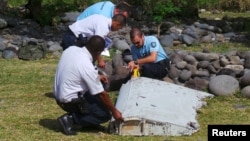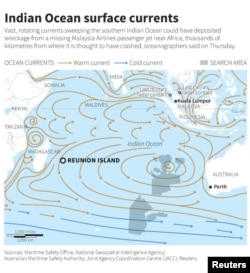Investigators in Toulouse, France, will start examining a piece of plane debris found on Reunion Island to determine whether the numbers found on the object correspond with the Malaysian Airlines jet that mysteriously vanished in March 2014.
The 2-meter-long fragment, a wing component called a flaperon, was found Wednesday on a beach on Reunion Island, which is east of Madagascar and more than 3,500 kilometers (2,175 miles) from where the Boeing 777 was last tracked.
Experts said they thought the results of the investigation would be positive, based on the shape of the recovered piece and the holes that connect it to other parts of the plane.
Airline recovery expert Steve Saint Amour said he wasn't surprised at the distance between the spot of the discovery and the last area where the plane was tracked. He said strong currents in the middle of the Indian Ocean come up the Australian coast south to north, and about at Port Hedland in Western Australia they swerve west across the Indian Ocean and hit Madagascar.
Boeing 777
The discovery was made this week by workers who were cleaning a beach on Reunion Island.
They gave photos to French aviation expert Xavier Tytelman, who told VOA he was confident the plane part belonged to a Boeing 777.
"We only found one match; it was with the flaperon of the Boeing 777," Tytleman told VOA via telephone. "It was not only the shape that matched, but also the holes for the connections in it."
Wayne Plucker, an aerospace expert with Frost and Sullivan, a consulting firm in San Antonio, Texas, said the recovered piece “almost has to be” from Flight MH370.
There is "an amazing amount of forensics you can do" in studying one part, Plucker told VOA.
For instance, crash investigators can look at the angle of the tears on metal fabric and the rivets to determine the speed and angle of a plane before an accident. Even the type of marine animals clinging to the wreckage can indicate whether the fragment spent more time in cold water than in warm water, which will help guide searchers.
But, as others pointed out, such tests won't show who was at the controls of the plane or whether there was any ill intent.
Australian Deputy Prime Minister Warren Truss, who has been leading the search for the plane off the southwest coast of Australia, called the latest discovery a potential breakthrough.
"It won't be all that helpful in pinpointing precisely where the aircraft might be located," Truss said. "But if this wreckage is linked to MH370, it'll certainly confirm that the aircraft has gone into the water in the Indian Ocean."
It is not implausible that wreckage from MH370 made its way to Reunion Island from the location where officials believe the plane went down, said Erik van Sebille, an oceanographer at Imperial College London.
Ocean currents
Van Sebille, who studies how debris travels across the ocean, said investigators may be able to use ocean currents and wind patterns to determine a rough location for the crash site.
"It's not an easy task to do because over 17 months, the ocean is so chaotic and there is so much turbulence," van Sebille told VOA.
"If you start somewhere and you backtrack where the plane might have hit the water, you end up with an area that is probably a few hundred miles in diameter," he said.
But such projections would take a significant amount of time.
"Computers may be able to calculate ocean currents, time and distances to trace back a reasonable point of origin — if possible, this will take time — and then deep-sea searching must start all over again," said the aviation website Leeham News in a post late Wednesday.
Truss, Australia's deputy prime minister, Thursday insisted that authorities still thought the plane was somewhere within the current search area, and said the discovery of the debris was not likely to lead to any change in the search strategy for now.
The Malaysia Airlines flight, which was carrying 239 people, took off from Kuala Lumpur on March 8, 2014, on its way to Beijing. It vanished from radar more than a hour later, somewhere over the South China Sea.
Malaysian investigators have said they believe someone with knowledge of aircraft deliberately turned off the plane's tracking devices and diverted the plane, but an investigation has turned up few clues.
VOA's Carolyn Presutti contributed to this report.
VIEW: Photos from early in search for missing plane
















